 Rich Wasowski, director of Miracle on 34th St., prompts the youngest, potential cast members with enthusiasm as they begin the process of auditioning for play parts while supportive family and friends form their audience. Costume designer Jenna Gribben (small photo lower right) begins the cast dressing process with measurements of Caleb Tate who will be playing Harper's Grandchild.
Rich Wasowski, director of Miracle on 34th St., prompts the youngest, potential cast members with enthusiasm as they begin the process of auditioning for play parts while supportive family and friends form their audience. Costume designer Jenna Gribben (small photo lower right) begins the cast dressing process with measurements of Caleb Tate who will be playing Harper's Grandchild.
THE
MANSFIELD
PLAYHOUSE
PRESENTS...........
The old 1st Alliance Church on E. Third St. has been aglow with secular creativity since 1967 when The Mansfield Playhouse, the second oldest community theater in Ohio, did Brigadoon, its first production there.
The playhouse and its predecessors have been producing local plays since 1929 and, a stunning amount of behind the scenes activity precedes every play’s ultimately polished appearance on stage.
Longtime theater manager Susie Schaus explains the normal velocity of activity at the playhouse, “During our season which runs from September to June there is almost always a play in rehearsal while auditions are being held for the next following production; all this before the current production ends.”

The set for the next production, The Miracle on 34th St., was under construction before the stage was cleared after the previous show. When opening night arrives December 5th more than 50 volunteers will be involved in support of the actual cast and crew.
It costs about $6,000 to put on a show.
Auditions, the first formal activity of a new play, began October 20th when 76 local folks tried out for parts. By the 27th the 33 cast members were in rehearsals which will continue almost daily until opening night.
By the 28th they were being measured for costumes.
On November 10th the stage was cleared of the set for the previous production—which closed on the 9th—and the Miracle’s cast moved upstairs for their first rehearsal on the main stage.
The play has 34 different scenes that director Rich Wasowski and team need to polish into opening night perfection.
By opening night nearly 100 hours of rehearsal alone will have been completed. It is nearly impossible to calculate the total hours devoted to getting a play to opening night when one considers such additional jobs as costuming, set production, and technical engineering among a zillion other tasks.
Miracle on 34th St., is a Christmas classic. Kris Kringle is the personification of good will and holiday spirit. As Macy’s holiday Santa, he enchants children and shoppers so completely he is deemed dangerous by fellow employees who plot to ruin him. A small girl’s belief in Santa and the magic of the holiday is at stake in a climactic courtroom decision.
Click here for more information.
Do yourself a favor; the tickets are modestly priced and the productions are easily near-Broadway quality right here on E. Third St., in our hometown, USA.
Break a leg, cast and crew!
 Director Wasowski (above) coaxes perfection from Carmone Macfarlane playing Dr. Pierce as she tells Santa Kris (played by Gordi Wendling, a Mansfield policeman) he might have to go to a sanatorium while Don Lincicome as Mr. Shellhamer awaits his cue.
Director Wasowski (above) coaxes perfection from Carmone Macfarlane playing Dr. Pierce as she tells Santa Kris (played by Gordi Wendling, a Mansfield policeman) he might have to go to a sanatorium while Don Lincicome as Mr. Shellhamer awaits his cue.
Do yourself a favor; the tickets are modestly priced and the productions are easily near-Broadway quality right here on E. Third St., in our hometown, USA.
Break a leg, cast and crew!
 Director Wasowski (above) coaxes perfection from Carmone Macfarlane playing Dr. Pierce as she tells Santa Kris (played by Gordi Wendling, a Mansfield policeman) he might have to go to a sanatorium while Don Lincicome as Mr. Shellhamer awaits his cue.
Director Wasowski (above) coaxes perfection from Carmone Macfarlane playing Dr. Pierce as she tells Santa Kris (played by Gordi Wendling, a Mansfield policeman) he might have to go to a sanatorium while Don Lincicome as Mr. Shellhamer awaits his cue.Next lower; Wasowski, Macfarlane and set designer Anna Plank begin the early stages of set construction. In the bottom photo, Jim Heydinger, lighting and sound technician, fine-tunes the positioning of stage lighting.
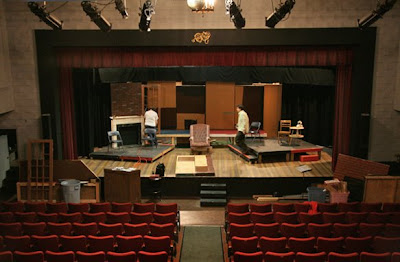
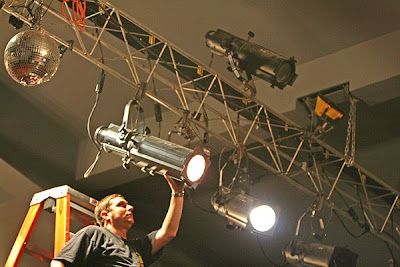



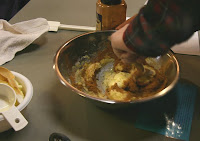

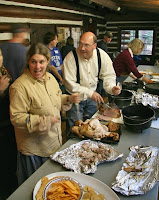



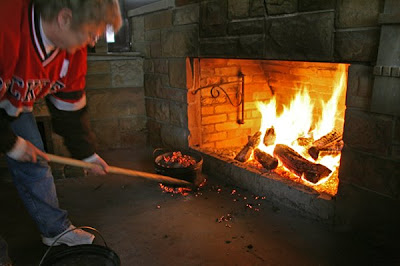



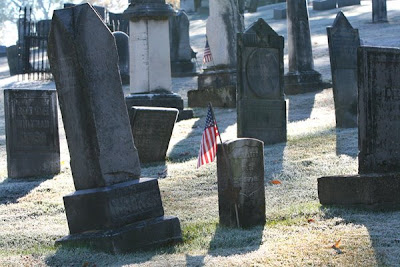

 Regardless, I headed up the wooded hill in a southerly, counterclockwise direction from the visitor’s center and was promptly rewarded with a sun dappled trail (above) where deer tracks were as obvious as those of horseshoes and the sounds of civilization were blessedly silenced.
Regardless, I headed up the wooded hill in a southerly, counterclockwise direction from the visitor’s center and was promptly rewarded with a sun dappled trail (above) where deer tracks were as obvious as those of horseshoes and the sounds of civilization were blessedly silenced.